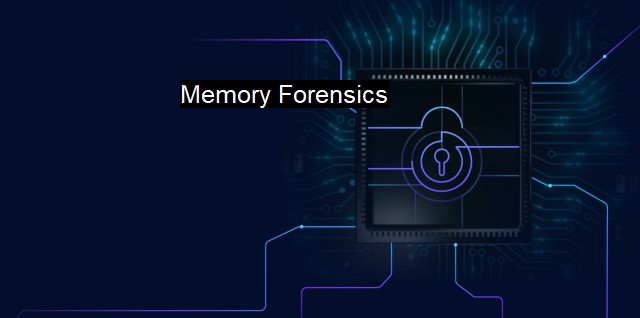What are Memory Forensics?
Exploring the Crucial Role of Memory Forensics in Cybersecurity: From Analysis to Attribution
Memory forensics, also known as digital forensic memory analysis, is a crucial aspect of cybersecurity and antivirus measures involving the assessment and analysis of data from computer memory (RAM) to uncover invaluable information that can assist in the investigation of digital crimes or cyber threats. This is a vital field as not all valuable data is stored on disk. Some are, by design or default, stored temporarily in a computer’s volatile memory, disappearing once the computer is shut down.Memory foregonsics is deemed highly effective because a sizable amount of digital evidence, such as running processes, open network connections, login sessions, or encryption keys, is readily available in volatile memory. These information sets can be instrumental in understanding both cyber attacks' processes and origins. As a distinct field in digital forensics, memory forensics enables cyberinvestigators to identify threats and secure systems more effectively to reinstate normal operations.
Memory forensics is a promising weapon in the antivirus war. In the fight against malware, the most advanced threats are those that employ such techniques as rootkits or bootkits and cannot be detected by traditional disk or file-focused forensics. Memory forensics provide increased visibility into the different types of malware that hide in memory, including some advanced or encrypted samples. Since memory images carry both runtime state and processed data, it is possible to extrapolate the behavioral information of malware from it.
Close examination of an infected system's memory also provides insight into various malicious software pieces, including viruses, spyware, Trojans, worms, and more. Suspicious or unfamiliar processes in a memory snapshot can serve as red flags, leading investigators to areas of concern. These threats can leave traces in the memory long after they have been eliminated from disk storage, making memory forensics invaluable for detecting and remedying the system's cogs.
There are numerous tools available for memory analysis. One of the more popular ones is the open-source Volatility Framework. This tool can extract digital artifacts from volatile memory dumps such as open network sockets, network connections, running processes, loaded kernel modules, cached encryption keys, command history and even unallocated data. Utilization of volatility and other similar kits helps to streamline memory forensics and improve upon the process items while dealing with real-world cyber threats.
There are some challenges faced by memory forensics. Coordinating the capture of RAM images in the midst of a system compromise can be difficult, especially if the intrusion was covert and advanced. memory forensics requires significant technical expertise to analyze the volatile memory manually and can be immensely time-consuming due to the mammoth sizes memory dumps usually come in.
Nonetheless, memory forensics is rising in importance because of the increase in sophisticated malware that takes cover in the system memory and the constant evolution of techniques used by hackers to circumvent traditional cybersecurity measures. By examining a computer's volatile memory directly, investigators are provided with a peek behind the digital curtain to an area previously obscured by advanced cyber threats.
Adopting memory forensics has been invaluable for the digital cyber response landscape's evolution, helping to ensure safe atmosphere for systems and networks. Investigators and cybersecurity professionals alike can harness both extensive data extraction techniques for conducting audits, countering threats, putting security breaches to an end, maintaining stable-rich habitat, and enforcing proactive prevention of advanced cyber threats. Emphasizing memory forensics in cyber investigations further empowers us to better understand the adversaries' tactics and threats, leading to more efficacious defense strategies and remediation techniques, turning the state of the cyber world into a more secure place.

Memory Forensics FAQs
What is memory forensics?
Memory forensics is the process of analyzing the volatile memory of a digital device, such as a computer or a smartphone, in order to extract and analyze information that may be useful for cybercrime investigations.How does memory forensics help in cybersecurity?
Memory forensics helps cybersecurity professionals by providing them with important insights into the running processes and activity on a device at the time of an incident. This information can be used to identify malware, understand how an attacker gained access to a system, and reconstruct the actions taken during an attack.What are some common tools used in memory forensics?
Some common tools used in memory forensics include Volatility, Rekall, and DumpIt. These tools allow investigators to examine the contents of a device's memory, including the run-time state of processes, network connections, and open files.How can antivirus software use memory forensics?
Antivirus software can use memory forensics to improve their detection and response capabilities. By analyzing the memory of a compromised device, an antivirus solution may be able to identify malware that is attempting to evade detection by hiding in memory rather than on the hard drive. Memory forensics can provide antivirus software with valuable insights into the behavior and characteristics of malware, allowing them to develop more effective signatures and heuristics.| | A | | | B | | | C | | | D | | | E | | | F | | | G | | | H | | | I | | | J | | | K | | | L | | | M | |
| | N | | | O | | | P | | | Q | | | R | | | S | | | T | | | U | | | V | | | W | | | X | | | Y | | | Z | |
| | 1 | | | 2 | | | 3 | | | 4 | | | 7 | | | 8 | | |||||||